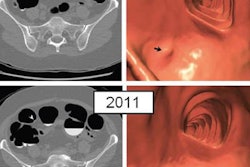
Citing the certainty provided by conventional optical colonoscopy (OC) results, a majority of radiologists would choose it over CT colonography (CTC) for their own colorectal cancer screening, according to the results of a small survey reported in the February American Journal of Roentgenology.
Researchers from the University of Pennsylvania presented individuals with a vignette that assumed insurance coverage of optical colonoscopy but required an out-of-pocket payment for CT colonography. The survey listed basic features of both exams and asked radiologists how much they would be willing to pay in three scenarios involving CTC.
Two-thirds of respondents said they'd choose optical colonoscopy over CTC, largely based on their view that OC results are definitive and would prevent them having to return for a second bowel prep if CTC found polyps, wrote Dr. Adam Kaye and colleagues (AJR, February 2016, Vol. 206:2, pp. 355-358).
"Over half of the people would prefer to get OC rather than taking the risk of having two bowel preps," Kaye told AuntMinnie.com. They also disliked the idea of waiting for results.
Mixed reviews in practice
CTC has received mixed reviews in clinical practice despite its high accuracy and lack of invasiveness compared to optical colonoscopy, though it does still usually require a cathartic bowel preparation. Concerns persist about radiation exposure to patients, as well as the quantity and severity of extracolonic abnormalities, despite evidence that both radiation and the rate of serious extracolonic abnormalities are low.
"CTC is a test you don't need conscious sedation for, and you can go to work later that day and drive yourself home," Kaye said. "But people tend to overweigh the perceived risks of having a second test" if they opt to start with CT colonography.
Willingness to pay (WTP), the basis on which the study weighed patient preferences, is useful for quantifying what really matters to patients, the authors wrote. The survey aimed to explore patient preferences among radiologists for CTC versus optical colonoscopy.
The online survey collected demographic information and risk factors for colorectal cancer from radiologists, who were then asked to choose between optical colonoscopy and CTC for themselves. Both procedures were described from the literature, including the need for bowel preparation in both procedures and sedation in OC.
In one scenario, participants were asked about their willingness to pay for CTC if OC was covered fully by insurance but CTC was not. The other two scenarios involved the same insurance coverage, but one also assumed perfect 100% sensitivity, specificity, and accuracy for CTC, while the other assumed that CTC was performed without bowel preparation.
Forty-two (35%) radiologists responded, with 28 (67%) preferring optical colonoscopy to CTC. No one was willing to pay more than $500 for CTC, and only five (12%) were willing to pay more than $250. The mean WTP for 100% sensitivity in CTC was $215. At 100% sensitivity, four of the radiologists would switch to CTC, but 24 (57%) still preferred OC. Given a choice between 100% sensitivity and 100% specificity, 74% chose sensitivity.
Twenty-four of the respondents (57%) said they would prefer CTC to optical colonoscopy if CTC could be performed without bowel preparation. The mean WTP for CTC without bowel prep was higher, at $318 (range, 0 to $800).
Promptness didn't matter: 26 respondents (62%) said that even if the results of CTC were available within 30 minutes, they would still want to leave the medical facility and get their results later.
"The most common reason (> 90%) for preferring OC was definitive results; that is, the respondents knew that if they needed polypectomy it would be performed at colonoscopy," Kaye and colleagues wrote.
One radiologist said that if optical colonoscopy were immediately available after CTC, then CTC would be preferred. Four radiologists chose CTC for its lack of sedation. One radiologist preferred CTC because it generates images and the possibility of second and third opinions, the authors wrote.
Multiple factors affecting decision
"We believe that our results hold important messages about the value of information with regard to screening," the group wrote.
Radiologists were chosen for the survey because they were thought to be informed and potentially open to the benefits of an imaging exam. But they did not opt for CTC, making the results seem counterintuitive, though some aspects of CTC had clear value for them.
Nearly 60% of radiologists were willing to pay for the opportunity to undergo optical colonoscopy on the same day CTC identified a suspicious finding, according to the authors. Most were not only averse to the discomfort of a second bowel prep, but also to the anxiety that accompanies the lack of full information when waiting for information about a potentially cancerous polyp.
The main reason for the OC preference is its definitive nature, "meaning if a polyp were found, it could be removed there and then," Kaye and colleagues wrote. "CTC does not allow that option and entails the possibility of a second round of stringent diet and bowel preparation."
A previous survey found that 13% of screening subjects would have skipped screening entirely had CTC been unavailable, highlighting the reality that screening is a personal decision. It "behooves the physician to incorporate patient preferences and explain the alternatives as dispassionately as possible when recommending ... a modality," they wrote.
Limitations included the study's single-center design. It would be interesting to compare physicians' preferences with those of nonphysicians, the team wrote.
Kaye noted that the information provided about CTC was limited. Radiologists were given optical colonoscopy's perforation rate and data on the mortality risks of conscious sedation, but they weren't told how often OC could not be completed, a situation that often leads to CTC referral.
Participants also weren't told about studies showing that CTC finds polyps optical colonoscopy misses. In fact, they were told to assume that optical colonoscopy had 100% sensitivity, because the survey was designed to alter numbers to assess willingness to pay, Kaye said.
"So it didn't really cross our minds to give the conflicting data about optical colonoscopy," he explained. However, these limitations may have increased the bias toward optical colonoscopy.
"There's much more work to be done on this -- for example, if you pushed this survey out to a different institution where there are different institutional cultures about how patients are screened, with the idea that it's a very complex issue to tackle in a survey," he said.
But there is a takeaway: "If you can offer same-day OC, you make CTC a more attractive option."




















